‘The isles of Greece, the isles of Greece, eternal summer gilds them yet…’
Lord Byron was on to something when he waxed lyrical about the Greek islands. But with more than 200 islands to choose from, which one is right for you? After a difficult decision, because of the fact that each island is unique and there is so much beauty to be revealed in any case, here are the best Greek islands to visit this summer.
These sunny islands are the perfect half-term hideout. Easy to get to, with fabulous beaches, clean waters, delicious food and a cheek-pinching matriarchal love of local people.
HYDRA
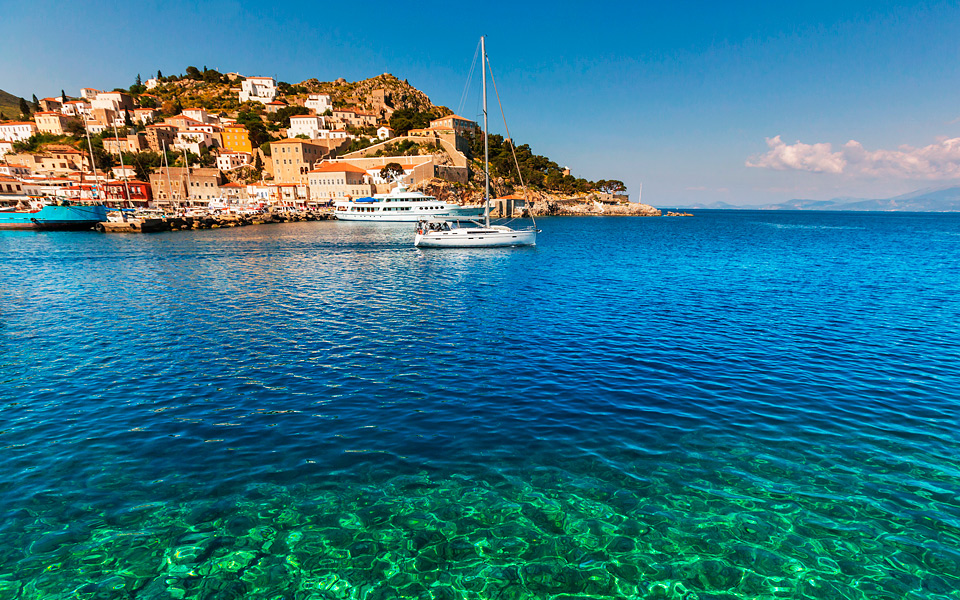
Best Greek island for: a long weekend with the art crowd
You know when Dakis Joannou, Greece’s foremost art collector, is on Hydra. His yacht, Guilty, is painted in garish ‘camouflage’ by Jeff Koons. Every summer, Joannou invites big hitters such as Matthew Barney and Maurizio Cattelan to create site-specific installations in the Greek island’s old slaughterhouse. Even the school is commandeered for exhibitions in the summer holidays. Car-free and protected by a preservation order, Hydra has always been the artists’ muse of the Greek Islands. Leonard Cohen, Brice Marden, and Juergen Teller have homes here. Athenian artists take up residence at the SCHOOL OF FINE ARTS, one of the vast, grey, stone mansions overlooking the horseshoe harbor.
Less than two hours from Athens, Hydra fills up with chic Greeks on weekends. Wily cats and weary donkeys patrol the back alleys, but all the action happens along the waterfront., Oh, and look! There’s Olivia Palermo at THE PIRATE BAR and Chloë Sevigny shaking her tail feather at HYDRONETTA BEACH BAR. Who cares if there are barely any beaches? You can always find a slab of rock from which to dive into the clearest water in the world.
MYKONOS

Best of the Greek islands for: Decadent parties and five-star hotels
Mykonos has seduced glamorous hedonists since the 1960s. It had gay clubs and sunrise parties before rave culture was even invented. Its bohemian allure has never faded, although nudist beaches now have nail bars, personal trainers, and house music pumping out all hours.
The influx of supermodels and superyachts has inspired ever more decadent resorts and restaurants. The latest place to show off your abs is SCORPIOS, a louche beach bar that puts Ibiza’s finest in the shade (book a cabana to watch the sunset). After hours, it’s always ASTRA, where you might find Keith Richards chatting up Karolina Kurkova.
If the glitzy excess gets too much, escape to KIKI’S, an off-grid grill-shack overlooking AGIOS SOSTIS BAY, where even Naomi Campbell has to queue for a table. Or cruise over to the tiny island of DELOS, an archaeological sanctuary that once thronged with 30,000 sun worshippers (the temple is dedicated to Apollo, the Greek god of light).
SANTORINI
Best for: Honeymooners and first-timers
Cooing American and Japanese honeymooners line up to take selfies as the sun sinks behind Santorini‘s flooded volcanic crater. That view may be a romantic cliché, but it still takes your breath away. A volcanic explosion blew out Santorini’s heart 3,500 years ago, leaving black-sand beaches, vertiginous cliffs in psychedelic hues, and swirling rumors about Atlantis in its wake.
The breathtaking view from the incredible & stylish Cavo Tagoo Santorini
The eruption also preserved the ancient city of AKROTIRI under layers of ash and created fertile ground for exceptional Assyrtiko grapes and Vinsanto wines.
Apart from a boat trip to the smoldering crater of NEA KAMENI and hot springs at PALIA KAMENI, there’s not much to do but gaze at the mesmerizing views from your suite, dangling on the edge of the caldera.
The breathtaking view from Grace Hotel, Santorini
The best hotels are concentrated in OIA, but the inland village of PYRGOS is up-and-coming. Go for a twilight Bellini at Franco’s then dinner at SELENE, a pioneer of new Cycladic cuisine.
SYMI
Best for: Castaway coves and a picture-perfect port
Little Symi has the prettiest port in Greece. As you round the headland, neoclassical mansions in every shade of apricot and peach rise like a mirage from the sea. Built by 19th-century sponge and spice merchants, the whole town is now a national monument. You need strong legs to explore – it’s about 500 steps up to the crumbling acropolis – but you won’t need a car.
The only proper road peters out at PANORMITIS MONASTERY, a major pilgrimage site. Ravishing beaches such as AYIOS YORGOS DISALONAS (backed by monumental cliffs) and MARATHOUNDA (where goats will try to filch your picnic) are only accessible by boat or on foot. In the rugged hinterland, more than 100 monasteries are hidden among the pine and cypress forests.
With its laid-back glamour, luminous sea and almost tropical microclimate, Symi is a hit with French and Italian yachties. You’ll find them eating flash-fried baby shrimp, a local specialty, at THOLOS, a sensational taverna where the harbor views almost steal the show.
CRETE
 Best for: Antiquities, active adventures and sunshine all year round
Best for: Antiquities, active adventures and sunshine all year round
Crete is the largest and most populous of the Greek islands, 88th-largest island in the world and the fifth-largest island in the Mediterranean Sea, after Sicily, Sardinia, Cyprus, and Corsica. Crete and a number of surrounding islands and islets constitute the region of Crete (Greek: Περιφέρεια Κρήτης), one of the 13 top-level administrative units of Greece. The capital and the largest city is Heraklion. As of 2011, the region had a population of 623,065.
Crete forms a significant part of the economy and cultural heritage of Greece while retaining its own local cultural traits (such as its own poetry and music). It was once the center of the Minoan civilization (c. 2700–1420 BC), which is currently regarded as the earliest recorded civilization in Europe.
Crete is mountainous, and its character is defined by a high mountain range crossing from west to east, formed by three different groups of mountains:
- The White Mountains or Lefka Ori 2,452 m (8,045 ft)
- The Idi Range with Psiloritis 2,456 m (8,058 ft) and Kedros 1,777 m (5,830 ft)
- The Dikti Mountains Dikti 2,148 m (7,047 ft) and Thripti 1,489 m (4,885 ft)
These mountains lavished Crete with valleys, such as Amari valley, fertile plateaus, such as Lasithi plateau, Omalos and Nidha; caves, such as Gourgouthakas, Diktaion, and Idaion (the birthplace of the ancient Greek god Zeus); and a number of gorges.
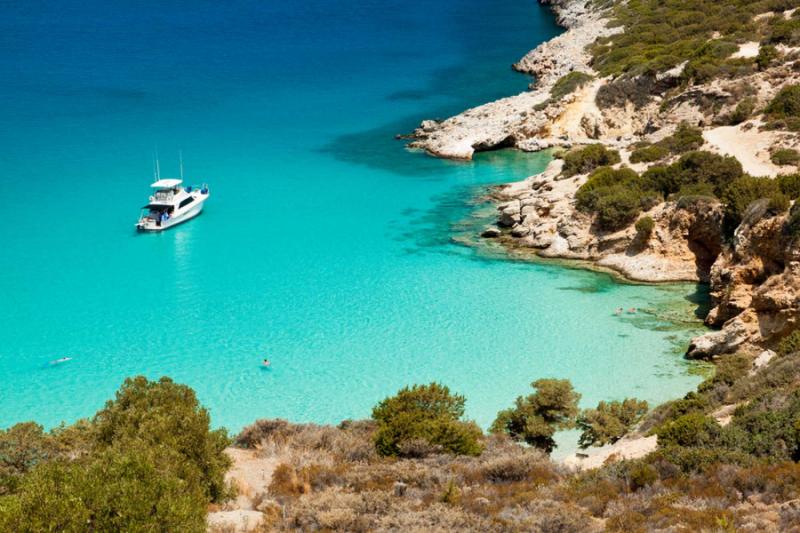
Gorges, rivers and lakes
The island has a number of gorges, such as the Samariá Gorge, Imbros Gorge, Kourtaliotiko Gorge, Ha Gorge, Platania gorge, the Gorge of the Dead (at Kato Zakros, Sitia) and Richtis Gorge and (Richtis) waterfall at Exo Mouliana in Sitia.
The rivers of Crete include the Ieropotamos River, the Koiliaris, the Anapodiaris, the Almiros, the Giofyros, and Megas Potamos. There are only two freshwater lakes: Lake Kournas and Lake Agia, which are both in Chania regional unit. Lake Voulismeni at the coast, at Aghios Nikolaos, was formerly a freshwater lake but is now connected to the sea, in Lasithi. Lakes that were created by dams also exist in Crete: the lake of Aposelemis dam, the lake of Potamos dam, and the lake of Mpramiana dam.
Popular tourist attractions include the archaeological sites of the Minoan civilisation, the Venetian old city and port of Chania, the Venetian castle at Rethymno, the gorge of Samaria, the islands of Chrysi, Elafonisi, Gramvousa, and Spinalonga and the Palm Beach of Vai, which is the largest natural palm forest in Europe.
NAXOS

Best for: Endless sandy beaches & Amazing Homemade Food
Naxiots once made considerable fortunes exporting potatoes, cheese, marble, and emery. Locals bequeathed undesirable seaside plots – useless for farming – to their laziest offspring. When tourists cottoned on to the island’s scores of fabulous beaches, these wastrels found themselves sitting on gold mines.
The west coast of Naxos is fringed with mile upon mile of powdery sands. AGIOS PROKOPIOS and AGIA ANNAdelight toddlers and teenagers alike with their shallow waters and beach bars.
As you head south, the beaches get wilder: PLAKA, where you can gallop across the dunes on horseback, MIKRI VIGLA for windsurfing and kitesurfing, and crystal-clear KASTRAKI.
Should you tire of frolicking on the shore, three supersized kouros statues are hidden in the hills and there are dozens of drowsy villages to explore.
Try kitron, the local citron liqueur, at the VALLINDRAS DISTILLERY in HALKI or sample homemade wine and arseniko cheese under the plane trees in ANO POTAMIA VILLAGE. No wonder Herodotus described Naxos as ‘the happiest of islands’
TINOS

Best for: Traditional villages and knockout tavernas
In antiquity, Tinos was also known as Ophiussa (from ophis, Greek for snake) and Hydroessa (from hydor, Greek for water). The closest islands are Andros, Delos, and Mykonos. It has a land area of 194.464 square kilometers (75.083 sq mi) and a 2011 census population of 8,636 inhabitants.
Tinos has more than 50 villages, each vying to be fairest of them all. In PYRGOS, famous for its marble craftsmen, sculpted birds and flowers decorate every doorway. In VOLAX, basket weavers squat outside cottages carved from giant boulders, seemingly flung from the heavens by Zeus in a fit of pique. There’s even a village called love, AGAPI, where you can tuck into wild-fennel fritters at the only taverna.
Tinos takes its food culture seriously: there are artichoke, caper and honey festivals. Greeks travel for days to eat cuttlefish risotto at THALASSAKI, served on the jetty in ISTERNIA BAY, then watch dusk bleed into the horizon from EXOMERIA BAR.
Tinos is only 15 minutes from Mykonos, so it’s a wonder it isn’t overrun with tourists. The harbor is swarmed on 15 August, however, when Orthodox pilgrims flock here to kiss the icons at PANAGIA EVANGELISTRIA MONASTERY, one of the holiest sites in Greece.
Tinos is famous amongst Greeks for the Church of Panagia Evangelistria, its 80 or so windmills, about 1000 artistic dovecotes, 50 active villages and its Venetian fortifications at the mountain, Exomvourgo. On Tinos, both Greek Orthodox and Roman Catholic populations co-exist, and the island is also well known for its famous sculptors and painters, such as Nikolaos Gysis, Yannoulis Chalepas, and Nikiforos Lytras.
Otherwise, the island is miraculously untouched. Solitary chapels and whimsical dovecotes stud thyme-scented hills, dropping to sandy bays whipped by the Meltemi wind. There’s a nascent surfer scene on KOLIBITHRA BEACH.
Landscape
Tinos has a varied landscape. From the shores of Panormos and Kolimbithra on the North Shore to Kionia, Agios Yannis O Portos, and Agios Sostis on the Southern Shore, Tinos has many beaches. Tsiknias is the highest mountain on the island at 750 metres (2,460 feet) and hides the village of Livada. The mountain of Exobourgo is quite distinct, and unlike its more rounded Cycladic neighbors, has a jagged appearance that would be more at home in the Alps. Between Tsiknias and Exobourgo lies the fruitful plain of Falatados. This area is unique on the island as its relatively flat terrain (albeit with an elevation of about 300 metres (980 feet)) is rare on the island. This made it a strong candidate for a proposed airport on the island. The Meltemi winds and concerns of local villagers of the towns of Falatados, and Steni have all but halted the project.
All around the island of Tinos, the islanders have made the most unusual things out of stone. The hills are all terraced with stone walls and every village is connected to its nearest neighbors by stone walkways set between a parallel set of stone walls.
MILOS
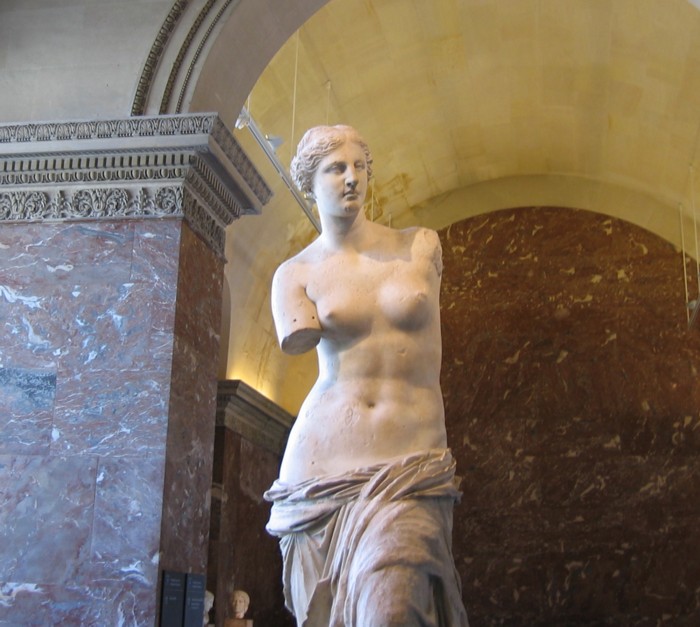
Best for: the Untouched Greek Island You’ve Been Looking For…
The island has a mythological landscape, uncrowded tavern-lined port towns, and the bluest water in the Cyclades. It is a volcanic Greek island in the Aegean Sea, just north of the Sea of Crete. Milos is the southwesternmost island in the Cyclades group.
The island is famous for the statue of Aphrodite (the “Venus de Milo“, now in the Louvre),
and also for statues of the Greek god Asclepius (now in the British Museum), the Poseidon and an archaic Apollo in Athens. Milos is a popular tourist destination during the summer. The Municipality of Milos also includes the uninhabited offshore islands of Antimilos and Akradies. The combined land area is 160.147 square kilometres (61.833 sq mi) and the 2011 census population was 4,977 inhabitants.
AMONG THE ISLANDS OF THE CYCLADES, even of the world, Milos stands luminously in the history of art. Not because a great artist came from here, or was inspired by it, but rather because of a chance discovery in its soil.
“…The luminous Greek Island of Milos has the best beaches in the Aegean, a fascinating history and superb seafood – and yet it is so often overlooked. All the better for the few who do go there, entirely alone in its turquoise bays..” Conde Nast Traveller
Beaches on Milos
(north): Sarakiniko Beach, Papafragas, Kapros, Pachena, Alogomantra, Konstantinos, Mitakas, Mantrakia, Firopotamos, Nerodafni, Lakida, Plathiena, Fourkovouni, Areti, Pollonia, Gourado and Filakopi.
(South): Firiplaka, Paliochori, Provatas, Tsigrado, Agia Kyriaki, Psaravolada, Kleftiko, Gerontas, Gerakas, Agios Sostis, Mouchlioti, Katergo, Spathi, Firligos, Pialothiafes, Kalamos, Krotiraki, Psathi, Svoronou and Sakelari.
(West): Agios Ioannis, Cave of Sikia, Agathia, Triades and Ammoudaraki.
(East): Voudia, Thalassa, Paliorema, Tria Pagidia and Thiafes. (In the Bay Area): Hivadolimni, Lagada, Papikinou, Fatourena, Klima, Skinopi and Patrikia.
The North and South and bay beaches are tourist attractions. The east beaches are very quiet, and those to the west are also quiet beaches.
In Milos they are in rock-backed villages around the cape on the eastern side of the immense harbour – at Klima, Areti, Fourkovouni, Firopotamos and Mandrakia, whose beauty is incredible.
Milos’s colours and wealth and the shaping of its history derive from its having been flung out of the sea by volcanoes that blew around two million years ago, the principal crater forming one of the largest harbours in the Aegean at Adamas (‘diamond’ in Greek). Hot springs praised by Hippocrates still bubble up around the island. Obsidian was its first star mineral, the traders at Phylacopi selling it to the Minoans for weapons and razors. Pliny wrote of alum that rivalled Egypt’s and declared that it had the most abundant supply of sulphur in the known world. At Theorychia you can see the haunting remains of a sulphur mine clinging to a cliff striped in yellow, rusting wagons still on the tracks, the water crystal clear, the beach stones like a painter’s palette with the colours running together, an odour of rotten eggs in the air. An 11,000-year-old mining industry still thrives through the collection of kaolin, baryte, pozzolan and bentonite. All this geological munificence has produced crystals, solidified volcanic ash and streaks of oxidised metals that make you feel you are in a place that has been dreamed up rather than naturally evolved.
FOLEGANDROS

Best for: liveliest and beautiful chora in the Cyclades
With its beautiful main town, small hotels, picturesque houses and secluded coves, Folégandros offers the ideal Greek hideaway. However, as is so often the way, this fantastic island in the southern Cyclades is not the easiest to reach. Remote and rocky, it has no airport, no package tours and no chain hotels.
It is a small barren rocky island with an area of surface area is about 32 km2 E of Milos and S of Serifos. The used to be one of the most isolated islands in Greece where political exiles were sent, as recently as during the Junta of the Colonels (1967-72). Also, its town Chora has some of the best examples of Cycladic architecture. Unfortunately, the island has been “discovered” and its 600 hundred inhabitants multiply many times over every summer with tourists, complete with bars, discos etc. Still, it does have wonderful architecture and one can take many nice walks in its stark terrain.
Folegandros gets its name either from the son of King Minos of Crete or from the Phoenician word Phelekguduri meaning rock-built.
The main point of interest is Chora with its fantastic architecture. In Chora there is a small Folkloric Museum. Near Chora there is the church of Panayia which is built over a sheer cliff right over the ancient temple to Artemis. Legend has it that the church was looted by pirates who stole the icon of the Virgin. As the were getting away their boat capsized and they were drowned.
The icon returned to the foot of the cliff. Every year the islander take the icon for a tour of the island to commemorate the miracle. Under the church there is a large grotto Chrissospilia (Golden cave) with stalactites and ancient inscriptions. Again legend has it that Barbarossa’s treasure is buried within the grotto but no one has ever found it.
SIFNOS
Best for: Big, fat Greek feasts
Sifnos owes its foodie reputation to its most famous descendant, Nicholas Tselementes, who wrote the first Greek cookbook in 1910. Forget souvlaki and moussaka: here, chickpea croquettes and stewed capers are taverna staples.
The island is peppered with potteries that produce the earthenware casseroles used for revitháda (baked chickpeas) and mastello (lamb with red wine and dill). Traditional dishes are slow-roasted in a wood-fired oven at TO MERAKI TOU MANOLI, a local institution on sheltered VATHY BAY.
In postcard-pretty ARTEMONAS, all roads lead to THEODOROU, purveyors of nougat wafers and almond sweets since 1933. You can eat in your bikini at OMEGA 3, where locally foraged and fished ingredients are given an exotic twist: baby-calamari tempura, crayfish, saffron, and ouzo risotto. Lobsters are plucked straight from the sea at HERONISSOS, then served with spaghetti on the jetty. Sifnos is the right balance of low-key luxury and unspoiled authenticity.
ASTYPALEA
 Best for: Escaping the crowds
Best for: Escaping the crowds
A throwback to a gentler, slower, more elemental way of life, Astypalea is surprisingly easy to get to (daily one-hour flights from Athens). Every gap in the burnished hills frames a different view of HORA, cascading from the Venetian castle to seaside SKALA. The scent of saffron biscuits wafts through the whitewashed lanes. Tucked beneath the battlements, CASTRO BAR has a magical terrace that seems to float above the archipelago.
The nearest beach is LIVADI, a sort-of-resort surrounded by citrus orchards. The rest of the island is stark and wild. Treacherous tracks hurtle down to shingle bays such as VATSES, with a rocking beach bar, and KAMINAKIA, where Linda’s farm-to-table taverna serves the best roast goat in the Dodecanese.
If you really want to be alone, rent a motorboat from MALTEZANA, an old-time fishing village, and putter to KOUTSOMITI and KOUNOUPES, tiny islands connected by a double-sided beach. At VATHY, a lagoon where erotic graffiti was etched into the rocks 2,500 years ago, the only taverna is called GALINI (Peace). Which sums up Astypalea perfectly.
PATMOS
Best for: Stark mystique and show-stopping villas
Patmos has an indefinable je ne sais quoi – an otherworldly quality that radiates from its crowning glory, the medieval monastery of St John. This turreted fortress, bursting with Byzantine relics, is named after John the Divine, who conjured up his apocalyptic revelations in a cave nearby.
Pure-white CHORA, a World Heritage Site, is where A-listers and fashion editors stay. High walls and heavy doors conceal magnificent mansions dating back to the 16th century.
The almighty church has kept nightlife in check. If you must see and be seen, head to ASTIVI for watermelon Daiquiris or GEORGE’S PLACE on KAMBOS BEACH, where the full-moon parties last until sunrise. Beach life is generally languid and low-key; PSILI AMMOS and LIVADI GERANOUare our favourite hideouts. Dinner reservations are essential at BENETOS, for Med-Asian fusion on an organic farm, and LAMBI for grilled fish on a purple pebble beach.
Joining the Patmos in-crowd requires commitment. There’s no airport and it’s a nine-hour ferry journey from Athens, which keeps the hoi polloi at bay. Seriously reclusive types hop on a fishing boat from Patmos to MARATHI (population: 12) and play castaway at PANTELIS a divine taverna with rooms to let.
Source: Condé Nast Traveller and 14 pieces of Heaven to visit this summer, located in Greece | Classy and fabulous way of living

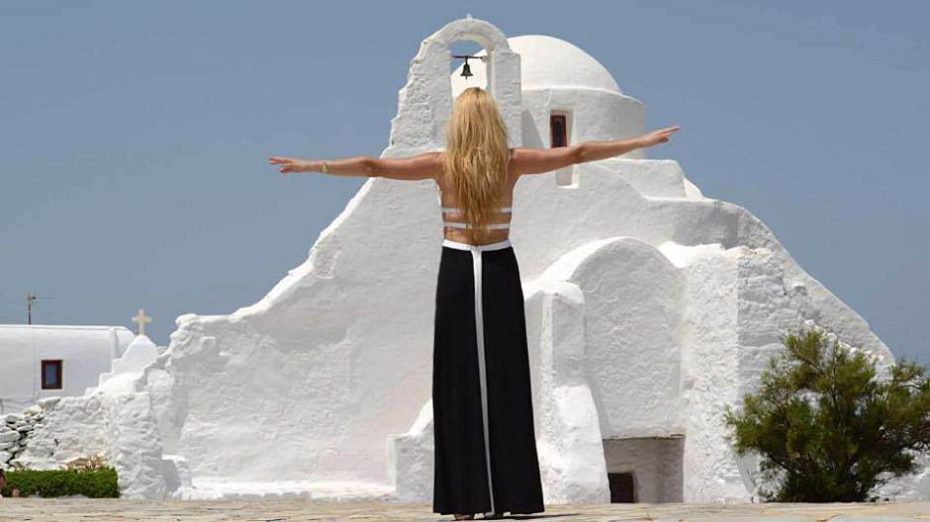
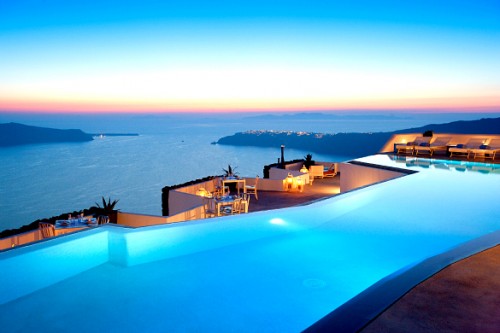
 Best for: Antiquities, active adventures and sunshine all year round
Best for: Antiquities, active adventures and sunshine all year round
 Best for: Escaping the crowds
Best for: Escaping the crowds